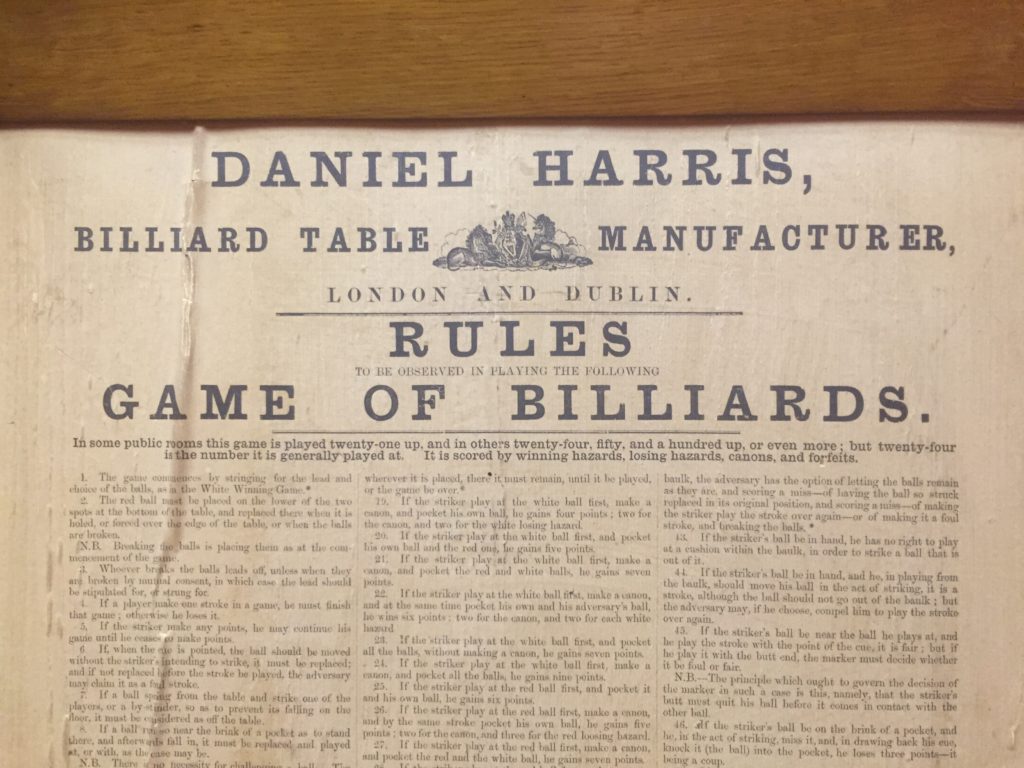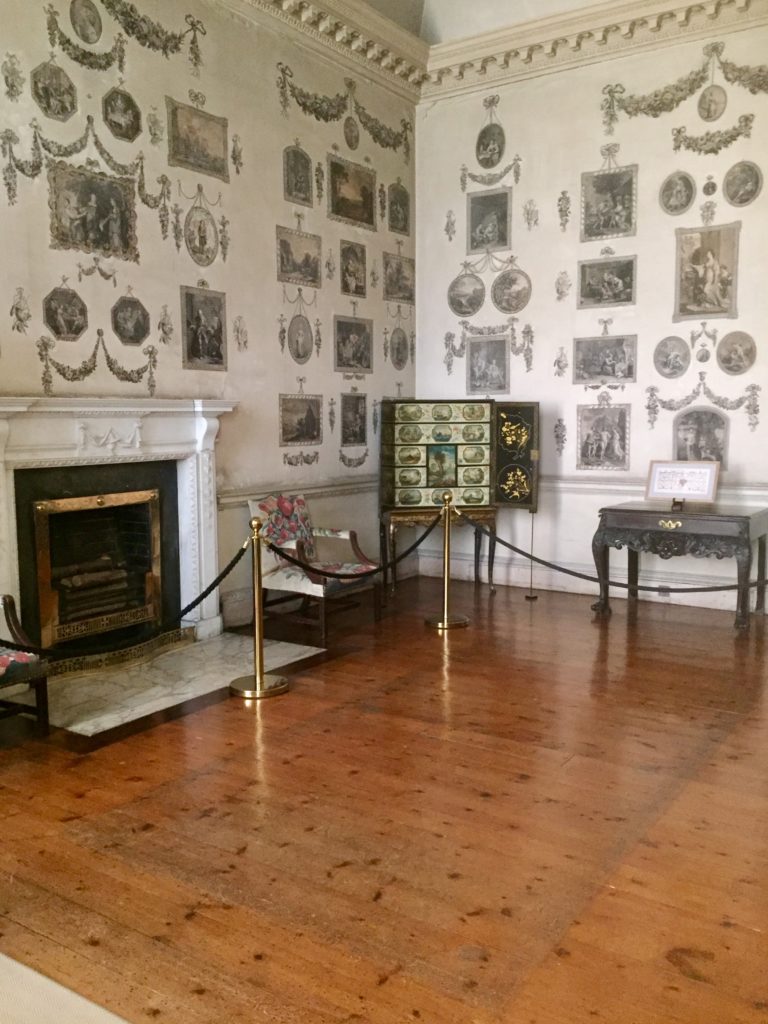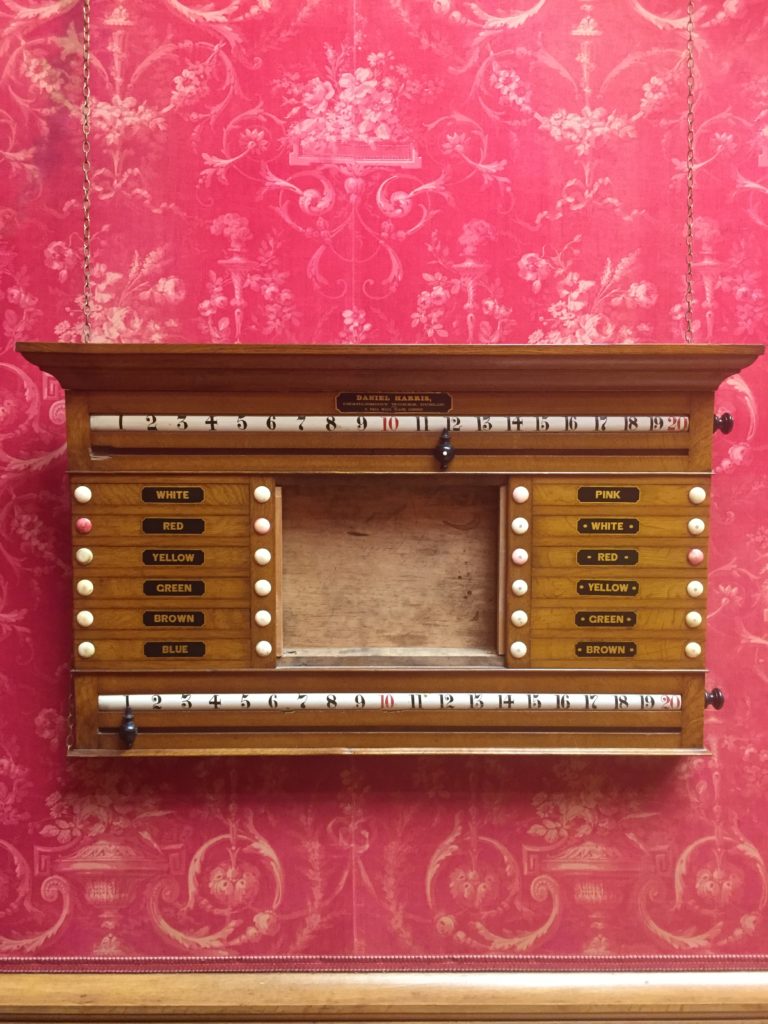By Dr James Curry, Guide & Information Officer
When I was a child my father taught me how to play pool, and although I was never able to become as good at the game as him – despite frequent boasts to the contrary – I did manage to become proficient enough to develop a genuine interest. During my teenage years this carried over into a liking for snooker, a more testing game that has memorably been described by some as ‘chess with balls’, and watching Ronnie O’Sullivan play matches today gives me much the same pleasure as my father got from watching Alex Higgins and Jimmy White in the past.
Therefore, after commencing employment at Farmleigh and receiving an introductory tour from Head Guide Maria O’Hanlon, my eyes immediately lit up upon entering the Billiard Room, one of Farmleigh House’s most visually striking spaces.

View of Farmleigh House’s Billiard Room from its north-eastern corner. The light above the snooker table is a replica of the original, commissioned by the OPW prior to Farmleigh’s reopening in 2001.
The Billiard Room at Farmleigh House
Located at mezzanine level between the ground and first floors, typical of nineteenth century billiard rooms to keep offending cigar odours away from the rest of the house and male visitors appropriately distanced from visiting ladies, it is very much a masculine enclave. Beneath a top-lit roof – reconstructed and reglazed with ultraviolet screens by the OPW – the plaster cornice, deep ceiling cove and decorative ribs are painted in imitation of timber. The oak chimneypiece with Corinthian columns and carved frieze to the south of the room is dark in colour, lending to the heaviness about the overall decor when combined with the distinctive red cotton wall fabric which is printed with an arabesque motif.
The antique mahogany snooker table that dominates Farmleigh’s Billiard Room is not original to the house. Installed by the OPW some five years ago, it is a nineteenth century model by Daniel Harris & Son, a Dublin manufacturer based at Charlemont Works, whose billiard and bagatelle table works business was established in 1826. Harris also operated in London during the 1860s and 1870s, first from premises at 257 Oxford Street and later at 3 Pall Mall Place. Among the firm’s more unique creations at the time were full-size tables framed entirely in cast-iron rather than wood or featuring only corner pockets!

The top section from one of the three framed prints regarding the rules of billiards and similar games which accompanies the snooker table at Farmleigh House. Note the Royal coat of arms beneath Daniel Harris’s name.
At just over 11 feet long and 6 feet wide, with a three-part slate bed, Farmleigh’s snooker table is slightly smaller than the Burroughes & Watts mahogany model originally kept in the same room. It does benefit, however, from the same pipeworks heating system beneath the table which was subsequently renovated and restored in its cast-iron enclosure by the OPW. Unusually for a full-size table, it has six rather than eight legs.

The cast-iron enclosure containing a renovated and restored pipeworks heating system beneath the snooker table at Farmleigh House. Note the circular imprint on the floor from one of the eight legs belonging to the Burroughes & Watts table formerly kept in the Billiard Room by the Guinness family.
A Tale of Two Auctions
The table originally belonged to Castletown House in Celbridge, Ireland’s largest and earliest Palladian style house, which was built in the 1720s for William Conolly, ‘Speaker of the Irish House of Commons and the wealthiest commoner in Ireland’. After Castletown was sold to a property developer in 1965 by William Conolly-Carew, 6th Baron Carew, the snooker table – dated to circa 1850-70, although possibly slightly later – would be auctioned off with the rest of the house’s contents the following year for a sum of £100. It would remain ‘in a townhouse in Portarlington, Co. Laois’ for over four decades, until obtained by the OPW on 26th November 2007 at an auction in Portlaoise.

Castletown House’s elegant Print Room, where the Harris & Son snooker table at Farmleigh was formerly located. Note the dark imprint on the floor from the cast-iron enclosure which had been kept under the table to keep it warm (photograph by James Curry).
While it seems that billiards had originally been played in Castletown’s magnificent Long Gallery on the first floor, the Harris & Son table ended up placed in its far smaller Print Room at ground floor level. Decorated by Lady Louisa Conolly and her sister Sarah in 1768, this elegant former anteroom – a most unlikely setting for games of snooker – is the only fully intact eighteenth century print room of its type in Ireland, and it was from here that the table was sold at auction with accompanying marking board, cues, accessories and over-table light fitting on 20th April 1966.
The Demise of Harris & Son
A half century earlier Harris & Son had been battling to stay in existence. Then operating from premises at 43½ Mary Street in Dublin, it endured an even more difficult time than other manufacturers during the First World War due to ‘billiards not being a necessary luxury’. An indication of the firm’s plight can be seen by how eager ‘Annie Harris, trading as Daniel Harris & Son’ was, in the summer of 1916, to be fully compensated for a billiard table and pair of velvet seats worth £95 that had been destroyed by fire at the Garrison Institute, 102 Middle Abbey Street, on the third day of the Easter Rising. Having only received payment of £32 from the Garrison Institute at the time of the ‘Irish Rebellion’, the firm was keen to claim the outstanding £63 as soon as possible, reacting with dismay when the Property Losses (Ireland) Committee based at St. Stephen’s Green concluded that £40 4s. more accurately reflected the loss of income suffered. If the disappearance of newspaper advertisements in the Irish press are to be taken as evidence, within a decade Harris & Son was out of business.

Missing the slate insert in its centre, the Daniel Harris manufactured marking board in Farmleigh House’s Billiard Room. Note the dozen ‘Life Pool’ panels between the roller bars used for conventional billiard scoring. Life Pool was a popular gambling game in the late nineteenth century, with the objective to pot your opponents’ balls and after taking their three lives claim the total pool of money at stake.
If you are a fan of snooker and would like to experience how I felt upon first entering the Billiard Room at Farmleigh, one of the most endangered spaces in the property when taken over by the OPW in 1999, tickets for guided tours of Farmleigh House can be booked online. Just don’t expect to be allowed pick up a cue and pot balls during your visit!


